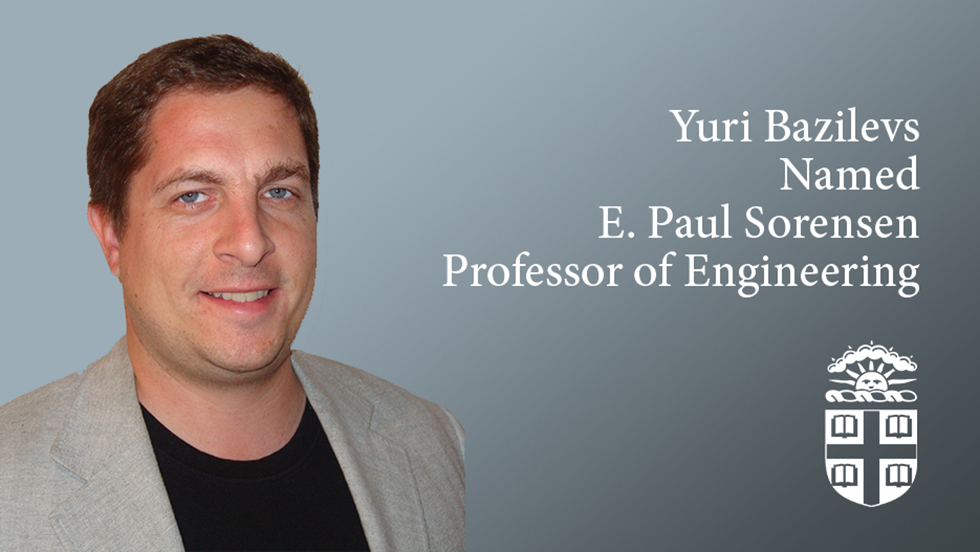 Yuri Bazilevs, former Vice Chair and Professor of Engineering in the Structural Engineering Department at the University of California, San Diego, has joined Brown University as the E. Paul Sorensen Professor of Engineering. Bazilevs' research interests lie in the field of computational science and engineering with an emphasis on computational mechanics.
Yuri Bazilevs, former Vice Chair and Professor of Engineering in the Structural Engineering Department at the University of California, San Diego, has joined Brown University as the E. Paul Sorensen Professor of Engineering. Bazilevs' research interests lie in the field of computational science and engineering with an emphasis on computational mechanics.
Bazilevs develops sophisticated computational methods and tools to build predictive models for a wide range of applications in engineering mechanics. His work addresses complex problems in the areas of biomedicine, such as the dynamic response of native and prosthetic heart structures (as in heart valves); renewable energy, such as assessing damage to wind turbines due to extreme conditions in harsh offshore environments; and protecting infrastructure against man-made and natural disasters, such as assessing the response of structures, including fracture and fragmentation, to terrorist attacks (as in bomb blasts).
He is the original developer of a computational technology called Isogeometric Analysis (IGA). In essence, IGA builds on the primitives of computer-aided design and computer graphics systems, generalizing and improving upon finite element analysis, with the potential to bridge the gap between design and analysis. IGA has had a significant impact in computational mechanics, and remains a prevailing research direction in the field today. The field of computational solid and structural mechanics has especially benefited from the development of IGA.
Bazilevs also works on fluid-structure interaction (FSI) analysis. He devised a fully-integrated FSI framework enabling him to solve problems of interest ranging from marine engineering to vascular blood flow. His FSI methods and software were employed to carry out simulations for a variety of industrial-scale applications. These include analysis and optimization of complex golf club designs, foil-based propulsion systems for recreational water sports, vortex mitigation devices for long-span bridges, hydraulic arresting systems for military aircraft, and loads prediction for military rotorcraft.
"I'm very excited to join the ranks of Brown faculty," Bazilevs said. "Brown has a long-standing tradition in engineering, and applied mechanics has been a traditional strength of the School of Engineering. I bring expertise in computational mechanics that will complement many research activities in the solid mechanics and other groups. In addition, Brown has a tremendous reputation in applied mathematics, and I look forward to teaming up with the Applied Mathematics faculty on the development of theoretically sound numerical methodologies that are able to address pressing challenges in engineering and applied sciences. I also look forward to working with research and clinical faculty and staff of the Warren Alpert Medical School to bring our advanced modeling and simulation capabilities to address challenges in predictive medicine applications."
Bazilevs earned his Ph.D. in Computational and Applied Mathematics from the University of Texas-Austin in 2006, and his M.S. and B.S. in Mechanical Engineering from Rensselaer Polytechnic Institute in 2001 and 2000, respectively. He was a J.T. Oden Postdoctoral Fellow at the Institute for Computational Engineering and Sciences (2006-2008) and a lecturer in the Department of Aerospace Engineering and Engineering Mechanics (2007-2008), both at the University of Texas-Austin. Bazilevs joined UCSD as an assistant professor in 2008, was promoted to associate professor with tenure in 2012, and, subsequently, to full professor in 2014. He was also an adjunct professor in the Mechanical and Aerospace Engineering Department in the Jacobs School of Engineering at UCSD.
Bazilevs' research is featured in over 135 peer-reviewed archival international journal papers, and he has written two books, one on IGA, and one on Computational FSI. His research has garnered over 21,000 citations on Google Scholar, and his h-index is 62. Most recently, he was named a recipient of the 2018 ASCE Walter L. Huber Research Prize. He has been included in the 2014, 2015, 2016, and 2017 Thomson-Reuters lists of Highly Cited Researchers and World's Most Influential Scientific Minds, both in the engineering and computer science categories. He is a fellow of the United States Association for Computational Mechanics (USACM) and currently serves on the executive committee of both the USACM and the American Society of Mechanical Engineers (ASME) Applied Mechanics Division.